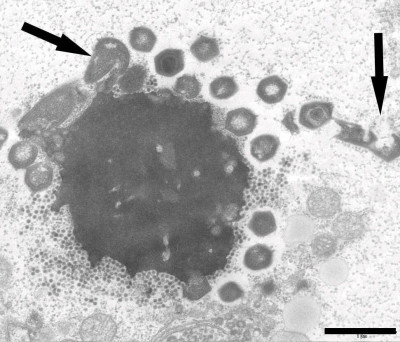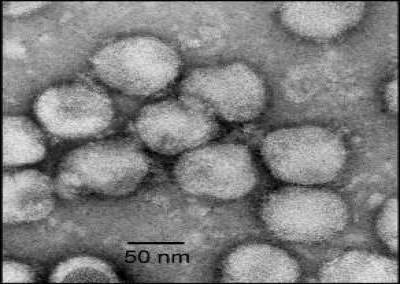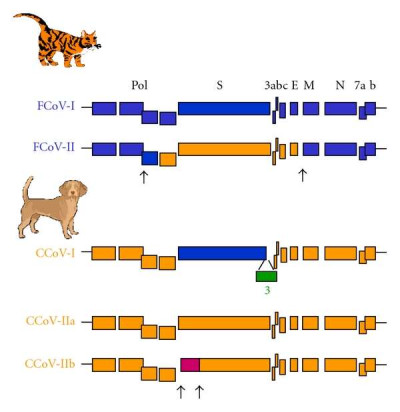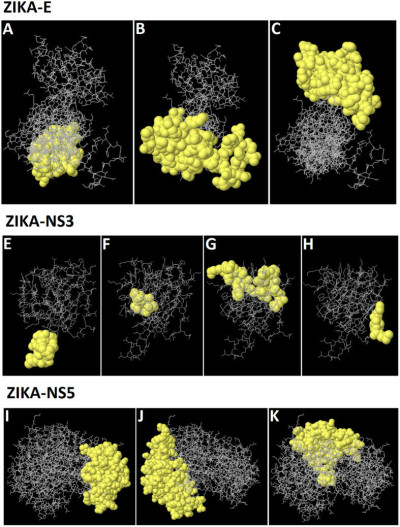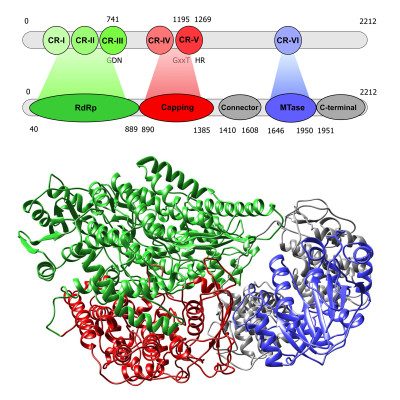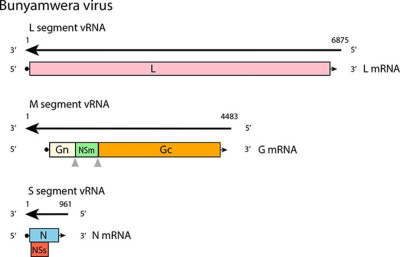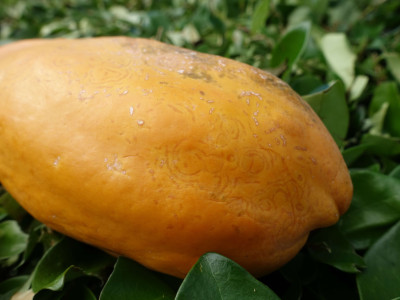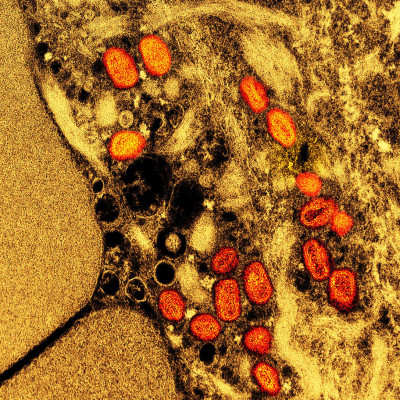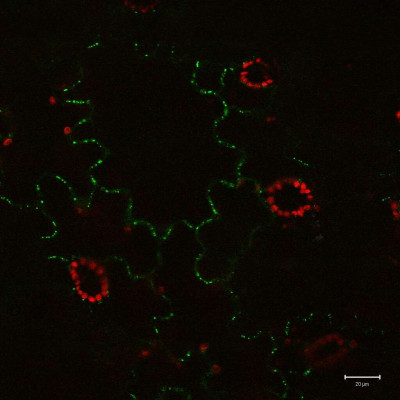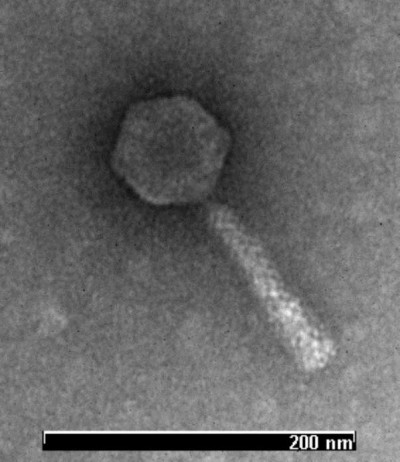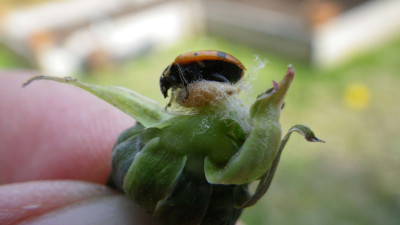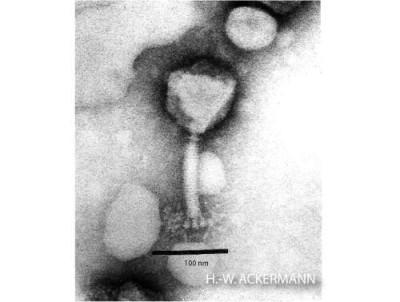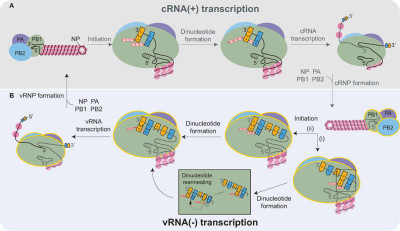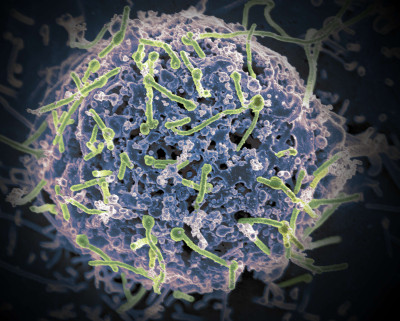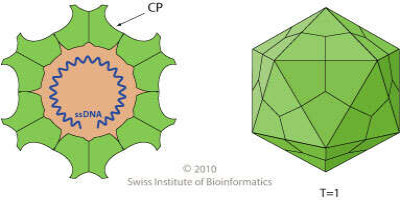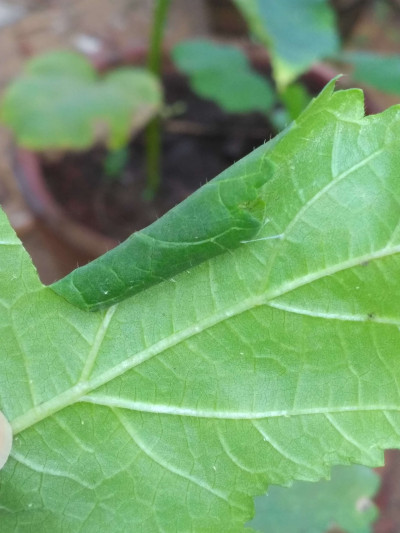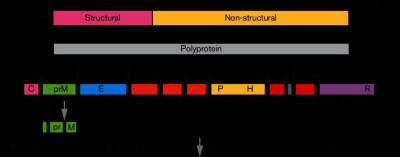Virus factory in amoeba co-infected with Zamilon and Mont1, showing abnormal Mont1 particles (arrows) (scale bar 0.1 µm). [1]
Morgan Gaia, Samia Benamar, Mondher Boughalmi, Isabelle Pagnier, Olivier Croce, Philippe Colson, Didier Raoult and Bernard La Scola, Wikimedia Commons
07 Feb 2024
Electron micrograph of negatively stained Nam Dinh virus (NDiV) virions.[1]
Phan Thi Nga, et al., Wikimedia Commons
22 Feb 2024
Genetic relationships between the different feline and canine coronaviruses genotypes (FCoV and CCoV). The feline sequences are coloured in blue, the canine sequences in orange, and the porcine sequences in purple. Arrows indicate the putative sites of recombinations. The genes encoding for the polymerase polyprotein (pol), the structural spike (S), the envelope (E), the membrane (M), and the nucleocapsid (N) proteins are indicated. The genes encoding the accessory proteins are designated by numerals.[1]
Sophie Le Poder, Wikimedia Commons
23 Feb 2024
3D Representation of the predicted discontinuous epitopes ( A to C ) of Zika-E protein, ( E to H ) of Zika-NS3 protein and ( I to K ) of Zika-NS5 protein. [1]
Muhammad Usman Mirza et. al., Wikimedia Commons
01 Mar 2024
Six conserved regions (CR-I to CR-VI) of amino acid sequence of L-protein and its five structural domains in different colors: RdRp, capping, connector, MTase, and C-terminal, as found in all Filoviridae polymerases. The ribbon structure represents structural organization of functional domains in Ebola L-polymerase: RdRP in green, Capping domain in red, Methyl-transferase domain in blue and the Connector and C-terminal structural domains in grey.
Francesco Pettini, Wikimedia Commons
01 Mar 2024
Genome of Bunyamwera virus. Translation of NSs protein is initiated at an alternative start codon. The Gn, NSm and Gc proteins are generated by co-translational cleavage of M polyprotein. [1]
Holly R. Hughes, Scott Adkins, Sergey Alkhovskiy, Martin Beer, Carol Blair, Charles H. Calisher, Mike Drebot, Amy J. Lambert, William Marciel de Souza, Marco Marklewitz, Márcio R. T. Nunes, Xiǎohóng Shí (石晓宏), and ICTV Report Consortium
01 Apr 2024
Papaya ringspot virus (PRSV).
Wikimedia Commons, Scot Nelson
01 Apr 2024
A model of the different fates of vRNA of flaviviruses. vRNA is replicated by NS5 within the vesicle packets (VP) with the assistance of other nonstructural proteins. Using vRNA, the positive strand (red), as a template, the synthesis of the negative strand (black) by NS5 is depicted. Subsequently, several new copies of vRNA are produced from the dsRNA replication intermediate (not shown). Translation presumably occurs outside of VPs since ribosomes can be visualized adjacent to these structures. vRNA is proposed to exit VPs through a pore to be directly encapsidated and enveloped into juxtaposed ER budding structures. Finally, vRNA is partially degraded by cellular XRN1 which generate sfRNA. sfRNA regulates several host responses including innate immunity at the levels of signal transduction and ISG translation. [1]
Wikimedia Commons, Clément Mazeaud, Wesley Freppel, and Laurent Chatel-Chaix
02 Apr 2024
Colorized transmission electron micrograph of monkeypox particles (orange) found within an infected cell (brown and yellow), cultured in the laboratory. Image captured at the NIAID Integrated Research Facility (IRF) in Fort Detrick, Maryland.
Wikimedia Commons, NAID
08 Apr 2024
This 1975 transmission electron micrograph (TEM) revealed the presence of a number of Eastern Equine Encephalitis (EEE) virus virions in this tissue specimen. EEE virus (EEEV) occurs in the eastern half of the United States where it causes disease in humans, horses, and some bird species. Because of the high mortality rate, EEE is regarded as one of the most serious mosquito-borne diseases in the United States. EEE is a Togaviridae virus family member, and the genus Alphavirus.
Public Health Image Library
11 Apr 2024
Tobacco mosaic virus movement protein fused to green fluorescent protein (GFP), transiently expressed in a Nicotiana benthamiana leaf and imaged with confocal microscopy.
Wikimedia Commons, Synapomorphy
23 Apr 2024
Clearly visible are the 'head' with DNA and the 'tail' proteins. Line scale is 200 nm in size. Practical: This was done using a phage suspension with a high titer (10^8-10^11 pfu/ml). The phage particles in the suspension were coated on a Cu grid covered with a plastic film. The excess material was then rinsed off and stained with uranyl acetate. This substance contains the electron-dense heavy metal U (uranium/uranium). Interpretation: The negatively colored particles are made visible by means of a transmission electron microscope (TEM). The phage particle is surrounded by the electron-dense substance (by surface tension), forming a brightness surrounded by a dark zone.
Wikimedia Commons, Dr. Jan Mast, CODA, Groeselenberg, Ukkel, Brussel
07 May 2024
Dinocampus coccinellae paralysis virus (DcPV) is a virus that infects parasitoid wasps of the species Dinocampus coccinellae, which parasitize ladybird beetles (coccinellids), specifically the species Coleomegilla maculata, commonly known as the spotted lady beetle. DcPV is a member of the family Dicistroviridae, which includes viruses with RNA genomes. The lady beetle is still (in this case, barely) alive, clutching the pupa of the parasitoid.
iNaturalist
11 May 2024
Non-enveloped, head-tail structure. Head is about 90 nm nm in diameter. The tail is contractile of about 110x18nm, has star-like fibers. The tail consists of a neck with a collar, a sheath surrounding a tail tube or core, and a thin baseplate. The tail sheath has 24 transverse striations.
H.-W. Ackermann, ViralZone, SIB Swiss Institute of Bioinformatics
31 Jan 2024
Transcription of the complimentary RNA (cRNA) and viral RNA (vRNA) by the heterotrimeric viral RNA-dependent RNA polymerase (PB2, PB1, and PA). (A) The viral polymerase initiates transcription of the positive-sense cRNA upon base-pairing of ATP and GTP with the complimentary nucleotides in the 3′ end of the vRNA. The subsequent formation of the A-G dinucleotide is followed by elongation of the cRNA transcript. Nucleoprotein (NP) molecules successively bind to the cRNA as it exits the polymerase, promoting cRNP assembly. cRNP formation is completed upon the termination of transcription and with the binding of a newly synthesized viral polymerase (yellow outline). (B) vRNA transcription proceeds in a similar manner as cRNA synthesis. Recent structures support a model where (i) ATP and GTP base pair to the nucleotides located 4 and 5 bases from the cRNA 3′ end, and there form a dinucleotide, which then disassociates and reanneals with the bases at positions 1 and 2. (ii) Alternatively, ATP and GTP could bind directly to the terminal nucleotides and form a dinucleotide. Both mechanisms would position the dinucleotide at the cRNA 3′ end, which is necessary to transcribe a full-length vRNA. Similar to cRNP formation, multiple NPs and a viral polymerase bind to the newly transcribed vRNA to produce a new viral ribonucleoprotein (vRNP). [1]
Wikimedia Commons, Dan Dou, Rebecca Revol, Henrik Östbye, Hao Wang, and Robert Daniels
01 Feb 2024
Ebola virus isolated in November 2014 from patient blood samples obtained in Mali. The virus was isolated on Vero cells.
Wikimedia Commons, NIAID
02 Feb 2024
Schematic drawing of a parvoviridae virion. Non-enveloped, round, T=1 icosahedral symmetry, 18-26 nm in diameter. The capsid consists of 60 copies of CP protein.
ViralZone, SIB Swiss Institute of Bioinformatics, Wikimedia Commons
22 Feb 2024
Symptoms of bhindi pest attack.
Ajuusha, Wikimedia Commons
01 Mar 2024
Transmission electron micrograph (TEM) of a fat head minnow cell infected with an isolate of European catfish virus (ECV, genus Ranavirus). Nucleus (nu); virus inclusion body (VIB); paracrystalline array of non-enveloped virus particles (arrows); incomplete nucleocapsids (arrowheads); cytoplasm (cy); mitochondrion (mi); the bar represents 1 µm (from Hyatt et al. (2000). Arch. Virol., 145, 301; with permission). (insert) Transmission electron micrograph of particles of Frog virus 3 (FV-3, genus Ranavirus), budding from the plasma membrane. Arrows and arrowheads identify the viral envelope; the bar represents 200 nm.
Wikimedia Commons, Jancovich, J.K., Chinchar, V.G., Hyatt, A., Miyazaki, T., Williams, T., Zhang, Q.Y.
14 Mar 2024
Genome organization and polyprotein processing of members of the genus Flavivirus. Boxes below the genome indicate viral proteins generated by proteolytic processing. NCR, non-coding region.
Wikimedia Commons, Peter Simmonds, Paul Becher, Jens Bukh, Ernest A. Gould, Gregor Meyers, Tom Monath, Scott Muerhoff, Alexander Pletnev, Rebecca Rico-Hesse, Donald B. Smith, Jack T. Stapleton, and ICTV Report Consortium
01 Apr 2024
 Encyclopedia
Encyclopedia
